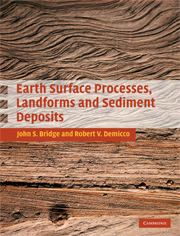Book contents
- Frontmatter
- Contents
- Acknowledgments
- Figure credits
- PART 1 Introduction
- PART 2 Production of sediment at the Earth's surface
- PART 3 Fundamentals of fluid flow, sediment transport, erosion, and deposition
- 5 Unidirectional turbulent water flow, sediment transport, erosion, and deposition
- 6 Air flow, sediment transport, erosion, and deposition
- 7 Multidirectional water flow, sediment transport, erosion, and deposition
- 8 Movement of sediment by gravity
- 9 Generation and movement of volcaniclastic sediment
- 10 Ice flow, sediment transport, erosion, and deposition
- 11 Biogenic and chemogenic depositional structures
- 12 Post-depositional deformation of soft sediment
- PART 4 Environments of erosion and deposition
- PART 5 Sediment into rock: diagenesis
- PART 6 Long-term, large-scale processes: mountains and sedimentary basins
- References
- Appendix: Methods of study of Earth surface processes, landforms, and sediments
- Index
- Plate section
12 - Post-depositional deformation of soft sediment
from PART 3 - Fundamentals of fluid flow, sediment transport, erosion, and deposition
Published online by Cambridge University Press: 05 June 2012
- Frontmatter
- Contents
- Acknowledgments
- Figure credits
- PART 1 Introduction
- PART 2 Production of sediment at the Earth's surface
- PART 3 Fundamentals of fluid flow, sediment transport, erosion, and deposition
- 5 Unidirectional turbulent water flow, sediment transport, erosion, and deposition
- 6 Air flow, sediment transport, erosion, and deposition
- 7 Multidirectional water flow, sediment transport, erosion, and deposition
- 8 Movement of sediment by gravity
- 9 Generation and movement of volcaniclastic sediment
- 10 Ice flow, sediment transport, erosion, and deposition
- 11 Biogenic and chemogenic depositional structures
- 12 Post-depositional deformation of soft sediment
- PART 4 Environments of erosion and deposition
- PART 5 Sediment into rock: diagenesis
- PART 6 Long-term, large-scale processes: mountains and sedimentary basins
- References
- Appendix: Methods of study of Earth surface processes, landforms, and sediments
- Index
- Plate section
Summary
Introduction
Some sedimentary structures indicate that sedimentary strata were deformed at the time of deposition or soon after, when the sediment was “soft” (Allen, 1982a, 1985). Biogenic deformation of soft sediment is discussed in Chapter 11, and purely physical deformation is considered here. The physical deformation of sedimentary strata requires low shear strength relative to the deforming force (commonly gravity or the surface tension of pore water in mud). Reduced shear strength may be associated with liquefaction, which occurs when the sediment grains become dispersed in a fluid and displace the fluid upwards as they settle downwards. However, deformed strata cannot be preserved if there is complete loss of shear strength and the sediment–fluid mixture flows. Low shear strength is commonly associated with high pore-water pressure and loose packing of grains (Chapter 8, Equation (8.1)) that can be produced by rapid deposition, low permeability, low cohesion, loading by landslides or water waves, and earthquake shaking. Rapid deposition of fine sand to silt is commonly conducive to soft-sediment deformation because of the low permeability and low cohesion of the sediment. The addition of water to sand confined between layers of impermeable mud is also conducive to an increase in pore-water pressure and a decrease of shear strength. The combination of high hydrostatic pressures on the bed under crests of large waves with low pressures under troughs results in cyclic shear stresses within bed sediment that can cause liquefaction.
- Type
- Chapter
- Information
- Earth Surface Processes, Landforms and Sediment Deposits , pp. 352 - 362Publisher: Cambridge University PressPrint publication year: 2008



